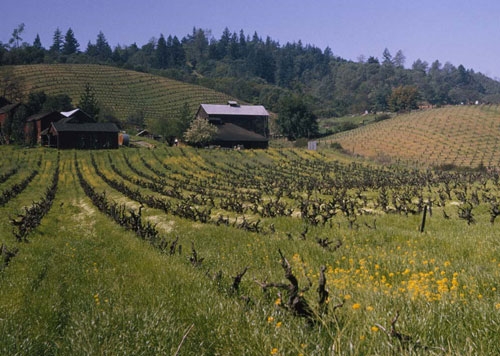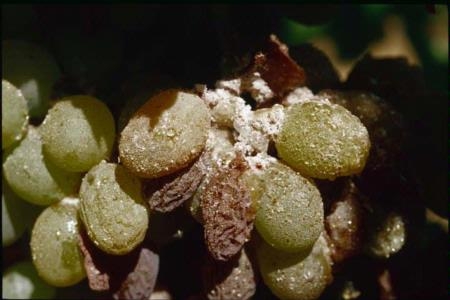
Posts Tagged: Golino
Fall colors in wine country are not a picture of health

In 2008, a disease characterized by red blotches along leaf margins and red veins under the leaf surfaces was seen in red grapes growing in Napa Valley. The symptoms resembled leafroll disease, however laboratory tests did not detect any leafroll and rugose wood viruses in the samples. Since then, red blotch disease has been observed in vineyards throughout North America.
The infected grapevines may produce clusters with reduced sugar content, causing delayed harvests. Poor color development and increased acidity are found in some clusters on diseased vines.
A virus associated with red blotch disease was identified in 2012. The incidence of the red blotch disease relative to other virus diseases is currently not known, according to the UC IPM Pest Management Guidelines. The guidelines, produced by UC Agriculture and Natural Resources' (UC ANR) Statewide Integrated Pest Management Project, offer comprehensive information free online for pest control in more than 50 California crops.
UC ANR Cooperative Extension specialist, Deborah Golino, director of Foundation Plant Services at UC Davis, wondered if the virus associated with red blotch disease was new to California. She turned to the UC Davis Herbarium, a repository of 300,000 pressed plant samples, including grapevines dating back to 1940.
Golino and her laboratory staff collected 56 samples and, to prevent contamination, tested them in a lab that only works with lettuce. Of the 56 samples, one, an early burgundy collected in Sonoma County, was positive.
“We have confirmed that red blotch disease is not new,” Golino said. “It's been around at least since 1940.”
The results were published this year by the American Phytopathological Society in the journal Plant Disease.
An initiative to manage endemic and invasive pests and diseases is part of UC Agriculture and Natural Resources Strategic Vision 2025.
New technology offers hope for solving grapevine red blotch disease

The virus is of particular concern to wine grape growers, whose grapes must reach a certain sugar content level before they are suitable for winemaking.
"The most urgent research need now is to determine how the virus spreads," said Deborah Golino, UC Cooperative Extension specialist in the Department of Plant Pathology at UC Davis and director of the UC Davis-based Foundation Plant Services.
"Due to the distribution of the virus in many parts of the United States and evidence that it can be transmitted by grafting, we suspect that red blotch disease is widespread wherever grapes are grown," Golino said.
Golino encouraged vineyard owners and managers to evaluate their vineyards for red blotch disease as they would for any other viruses.
Symptoms include blotches of pink or red veins on green leaves in the fall, when grape leaves would normally be turning a uniform gold color. Growers also might notice that their grapes are slow to develop sugar levels sufficient for winemaking, with some grapes never fully maturing.
"If there are visual signs of red blotch, as well as poor sugar development, growers should test their vines for both red blotch and leafroll virus because the symptoms of the two viruses are so similar," Golino said.
She reported that red blotch disease has been identified among both young and mature grape vineyards in California, New York, Virginia, Maryland, Pennsylvania, Texas and Washington. A virus almost genetically identical to red blotch also was found in Canada.
While the virus, also called grapevine red blotch-associated virus or GRBaV, likely can be found in all types of grapes, including rootstock, and table and raisin grapes, it was first detected in wine grapes because they are carefully monitored for sugar content to determine harvest date.
Presence of the virus in a vine can be confirmed using an extremely sensitive laboratory test known as polymerase chain reaction, or PCR, to detect small amounts of genetic material. This analytical process uses an amplification technique that multiplies the existing DNA and similar genetic material to identify the virus.
"If the vineyard tests positive for red blotch, the grower needs to decide, from an economic standpoint, when is the best time to remove the diseased vines and replant the vineyard," Golino said. "This is always a complex decision, and there is no one-case-fits-all answer."
Golino said that the Foundation Plant Services' Classic Foundation vineyard block, used for producing disease-free scion and rootstock vines, has been partially tested and appears to have a very low-level incidence of red blotch virus. Only three of the 1,600 vines tested to date were found to have the virus. Testing of all of the vines in the Classic Foundation vineyard, the source of the majority of grapevine nursery stock in California, is slated for completion in the months to come.
"The good news is that our new Russell Ranch Foundation Vineyard block has been tested, and there is no sign of red blotch virus in any of those vines," Golino said. This vineyard is propagated exclusively with vines that have been through tissue-culture therapy to exclude red blotch and other viruses. Test records from the Foundation Plant Services vineyards are available at http://fps.ucdavis.edu.
Golino cautioned that many more new viruses and other microbes are likely to be found in grapevines in the next few years, thanks to powerful new DNA sequencing technology.
"Some of those will be disease agents, some beneficial, and some neutral," she said. "We will have our work cut out for us in understanding the role of these microbes, but the ultimate result will be increased ability to create superior vineyards."
"The appearance of red blotch virus underscores the vital importance of the Foundation Plant Services and adequate funding for USDA's National Clean Plant Network," said John Aguirre, president of California Association of Winegrape Growers. "Growers need clean plant material to meet winery demands for increased winegrape production and improved quality."
Golino said that progress on identifying and characterizing red blotch has been a collaborative effort between many university-based researchers over the years.
Red blotch disease was first recognized in 2008 in a Napa Valley vineyard by Jim Wolpert, a UC Davis-based Cooperative Extension viticulturist, and Mike Anderson, a viticulture researcher and manager of UC Davis' Oakville Experiment Station.
Two UC Davis scientists - Mysore Sudarshana , a U.S. Department of Agriculture researcher in the plant pathology department, and Maher Al Rwahnih, a researcher at Foundation Plant Services - teamed up in an effort to identify the virus causing red blotch disease. Al Rwahnih was an early user of next-generation, or high-throughput DNA sequencing technology.
During today's meeting, Golino announced that California rootstock nurserymen acted last week to assist the California viticulture industry with research addressing GRBaV. The California Grape Rootstock Research Foundation, which funds research to enhance California viticulture and the grape nursery industry, has agreed to provide seed money to jumpstart research on the virus.
More information on red blotch disease is available on the University of California Integrated Viticulture website.
Foundation Plant Services is a self-supporting unit of the College of Agricultural and Environmental Sciences at UC Davis. The service, dedicated to the distribution of disease-tested, true-to-identity plant materials produced by UC researchers, plays a key national and international role in distributing new crop varieties and healthy planting stocks.
About UC Davis
For more than 100 years, UC Davis has engaged in teaching, research and public service that matter to California and transform the world.
Located close to the state capital, UC Davis has more than 33,000 students, more than 2,500 faculty and more than 21,000 staff, an annual research budget of nearly $750 million, a comprehensive health system and 13 specialized research centers. The university offers interdisciplinary graduate study and more than 100 undergraduate majors in four colleges -- Agricultural and Environmental Sciences, Biological Sciences, Engineering, and Letters and Science. It also houses six professional schools -- Education, Law, Management, Medicine, Veterinary Medicine and the Betty Irene Moore School of Nursing.
Media contacts:
- Deborah Golino, Foundation Plant Services, (530) 754-8102, dagolino@ucdavis.edu
- Pat Bailey, UC Davis News Service, (530) 752-9843, pjbailey@ucdavis.edu
UCCE teaching the next generation of farmers

“We recognize that the current population of farmers is aging, and that we need to get our younger farmers prepared and ranching,” said Stephanie Larson, UC Cooperative Extension advisor in Sonoma County and director of the new training program. “We’re really hoping to not only get more farmers and ranchers trained, but to increase food access and food production in Sonoma County, and also to teach more people about where their food comes from.”
Students in the program will split their time between classwork with ag teachers, field work with local farmers and business plan development with small business experts. The program will expand to include the broader farming community, connecting students with restaurants and grocers that buy local produce and the slew of farmers’ markets around the county.
“Programs like this strengthen the parts we already have and bring farmers together,” Larson said. “We used to work mainly in silos, but we’ve been breaking those silos down, and finding it works much better together than separately.”
Another blessing for Napa
Paul Franson, Napa Valley Register
On top of wine, food, arts and culture that some large cities might envy, Napa Valley has an invaluable, little-recognized asset: an uncommonly cooperative and educated wine industry.
Grape leafroll virus a headache for California farmers
Two relatively new variants of grape leafroll virus, known as V3 and V5, are alarming some winegrape growers in California's famed wine country, according to an article yesterday in the San Francisco Chronicle.
The virus is spread by grafting infected cuttings and by the feeding of vine mealybug. It won't kill the vineyard, but it will prevent normal sugar development and reduce yields.
The Chron article, written by Alice Feiring, said the late Ed Weber, Napa County's previous UC Cooperative Extension viticulture farm advisor, and Deborah Golino, director of Foundation Plant Services at UC Davis, in 2002 began a four-year study of the virus in an Oakville vineyard. During the study, there was a threefold increase in the number of infections in that vineyard alone.
UC Berkeley biological control specialist Kent Daane told the reporter that pesticides are not effective against vine mealybug because the bugs hide under leaves. A better control measure, Daane believes, is pheromone mating-disruption.
Nevertheless, Golino told the paper there will not be a fast fix. She encourages growers to purchase certified virus-free vines, "even when it means giving up field selections that have been a longtime part of a winemaking program."
The article also reported there is circumstantial evidence that shows vineyards managed organically might have natural predators for the vine mealybug.
"We don't see the problem in our organic vineyards as we do in our conventional," a farmer was quoted in the story. "But I'm not prepared to say that's the reason."

Vine mealybug feeding destroys grape clusters and spreads viruses.
Is *suitcase smuggling* to blame for new pest?
A few of California's top vintners admit to having smuggled grapevine cane cuttings into the United States to avoid a long wait for the plant to be cleared by USDA, according to an article that moved on the Associated Press wire over the weekend. The article was published in the Fresno Bee, the New York Times and other media outlets.
Some are wondering if what reporter Tracie Cone wrote is a "winked-at act of sneaking in vines" from Europe may have also imported the European grapevine moth, an Italian pest now threatening Napa vineyards.
The deputy agricultural commissioner for Napa County, Greg Clark, expressed his frustration with the practice of suitcase smuggling.
"There are people who continue to spin their tales of smuggled plant material," Clark was quoted. "People like a story with a glass of wine, and what that tends to do is legitimize behavior that not only threatens the industry, it's illegal. Knock it off."
Director of the UC Davis Foundation Plant Services, Deborah Golino, said some of the plant virus problems in Napa may also result from smuggling.
"The more we move plants around the world, the more chance there is of introducing problems," Golino was quoted.
Other theories about how the pest came to California are swirling around, the story said. In addition to the smuggled grapevine rumors, talk has centered around imported vineyard machinery or even deliberate introduction. Since the first detection of the pest was no where near a seaport, ag officials believe it unlikely the pest was transported on a container ship.
But UC Cooperative Extension viticulture farm advisor Monica Cooper said the moth's life cycle wouldn't be conducive to suitcase smuggling.
"I'm not saying that people don't still try to get suitcase wood in, but in this instance, I'm not sure the pest would be transported like that," Cooper was quoted.
More information and photos of the European grapevine moth are available on the UC Integrated Pest Management Web site.

European grapevine moth larva feeding on berries. (Photo: M. Cooper )
